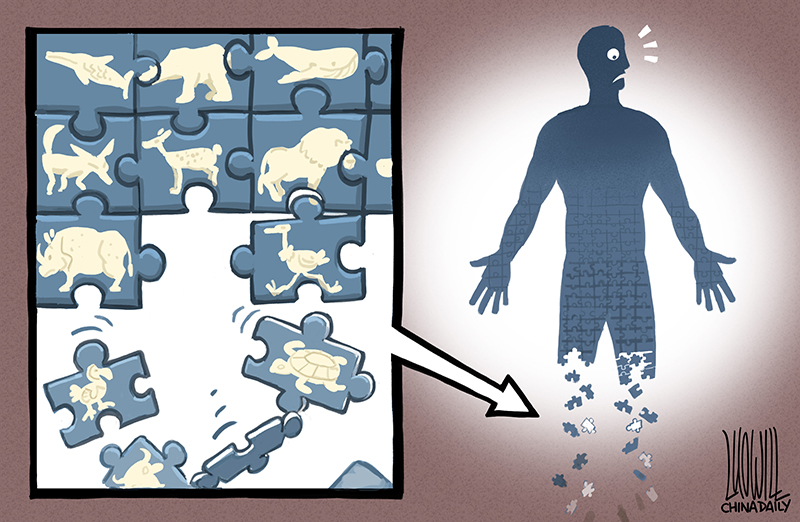
VANGUARD - Expressing the viewpoint of the Communist Party of Australia (Marxist-Leninist)
For National Independence and Socialism • www.cpaml.org
It’s hardly a secret that the capitalist class cares little about the wellbeing of our natural environment, and in particular the wellbeing of threatened species – those being species classified as vulnerable, endangered or critically endangered. In minds of the capitalists, preserving nature is more bothersome than beneficial, as protecting threatened species can be expensive, and protection rarely delivers any profit for anyone. The past few months have seen several demonstrations of this dangerous mindset at work.
The World Wildlife Fund’s 2022 Living Planet Report has outlined the global consequences, so far, of capitalist destruction of nature. It’s been calculated that within the past fifty years, the populations of wildlife species have decreased by, on average, 69%. And that’s the average, across the entire non-domesticated animal kingdom. For some groups of animals, types of habitats and parts of the world, that percentage is much higher – and of course for recently-extinct species it’s 100%.
This is not the kind of crisis which can be resolved simply by “putting the right people in charge”. While small efforts can and should make some amount of positive change, a capitalist market economy can simply never be sufficiently incentivised to take serious, effective action. Under capitalism it is strategically beneficial to be unethical, in this context environmentally, and the most unethical and exploitative capitalists naturally outcompete all others.
Environmental crisis in Australia
The end of November brought to light what environmental groups have called a “tangled mess of inaction” as the federal environmental department confirmed that 372 recovery plans for 575 threatened species and ecosystems, representing 89% of all active recovery plans, will reach their legislative use-by date by the end of this year. 355 of those 372 plans expire at the end of April. Past governments have failed to meet the requirements to update recovery plans every five years, and this is the result. The fact “inaction” and “under-resourcing” were cited among the causes of this blunder demonstrates how much, or rather how little, the capitalist class cares about these species.
This January a new study showed that among the 134 known species of cartilaginous fish (sharks and rays) which inhabit reef ecosystems, nearly two thirds are threatened with extinction and 14 are already critically endangered. Sharks and rays don’t always have the best reputation, of course, but I’ve personally dived with Stingrays in the past and I can verify that they are not only non-confrontational, politely moving out of the way so long as they have time to do so, but they’re even somewhat adorable. Certainly not the kind of animal that deserves to disappear from our waters.
‘Hidden’ threatened species
An important factor that must also be considered when discussing wildlife conservation is that the official number of threatened species is almost certainly just a fraction of the total. As mentioned previously, capitalists find it strategically bothersome to preserve nature, and as such there are a number of techniques that may be in place to artificially reduce the official number of threatened species from their actual total. First, a species may be misleadingly given a deceptively “comfortable” conservation status that doesn’t accurately reflect the situation it’s in. Second, a species may be prematurely declared extinct while a small handful hang on in remote areas, thus ending efforts to protect it. Third, a species may not be sufficiently evaluated to be given a conservation status, and a proper assessment of its status may be continuously postponed, leaving the seriousness of its situation uncertain. Fourth and finally, a species may not be “on the list”, so to speak, at all. This can either be because no-one has seen the species before, or because the body of evidence in support of the animal’s existence is officially considered insufficient to warrant further investigation.
This last point is often overlooked. People tend to be under the false assumption that the process of discovering our natural biosphere was some historical thing that ended at some point in the past. This is quite far from the truth. In fact, according to a research study published less than a year ago in late April of 2022, within the “Australasia” biogeographic realm (which encompasses Australia plus some surrounding islands such as New Guinea), in addition to the 122 species of land mammal officially known to exist there are probably around 19 left awaiting formal recognition. And that’s just land mammals – marine mammals, birds, non-avian reptiles, amphibians, fish, invertebrates, fungi, plants and so on almost certainly also contain currently “unregistered” species.
We cannot expect Australia’s (or for that matter, the world’s) environmental crisis to improve under a capitalist system. We should of course support and encourage what environmental efforts can be allowed under this system, but the longer the capitalist class is allowed to rule, the worse the crisis will get, the more species will go extinct, and the harder it will be to eventually recover in the future. Under socialist leadership, Australia will have a much easier time taking proper measures to protect every at-risk species in our rainforests, rivers, reefs, and so on.